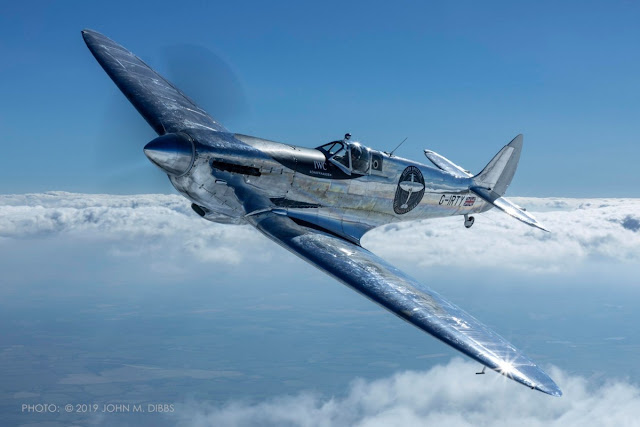Silver Spitfire - The Longest Flight logo.
August 5, 2019
Silver Spitfire around the World. Image Credits: John Dibbs/Simon Smith
Over the course of its long and storied military service, there isn’t a lot the Supermarine Spitfire hasn’t achieved. Designed by RJ Mitchell in the 1930s, it became perhaps the most famous combat aircraft in history, and was produced in greater numbers than any other during World War Two, with more than 20,000 churned out in less than a decade.
During the Battle of Britain (which marks its 78th anniversary today), the Spitfire – aided by the bulkier Hurricane –helped down 1,887 German planes in little more than three months. It became the envy of the enemy and the pride of the nation, and was flown all over the world, both by British and Allied forces, before, during and after the war.
Today, a diaspora of airworthy Spitfires continues to exist, faithfully maintained by enthusiasts around the globe. Yet there remains one challenge the aircraft has never quite managed: a complete circumnavigation of the globe.
But that may be about to change.
Silver Spitfire sets off for round-the-world flight
At the tail end of next summer, two British aviation enthusiasts, Matt Jones and Steve Brooks, intend to take off in a polished silver Spitfire Mark IX from southern England, head north-west, and return to Blighty by Christmas having pushed the aircraft to new limits.
When they touch back down, they will have made more than 150 stops in over 30 countries, soaring over many airspaces the Spitfire has never before entered, and flying over territories, such as the Far East and North Africa, where it hasn’t been seen since the war ended.
Image above: The Silver Spitfire will attempt the aircraft's first ever circumnavigation of the globe. Image Credits: John Dibbs/Simon Smith.
“It’s an ambitious adventure, but we’re on track and we’ll be ready,” says Brooks, 57. “The Spitfire is a real icon. The shape of its wings, the sound of its engine. It means so many things to so many people around the world, and we want to take it to as many of them as possible.”
Named Silver Spitfire – The Longest Flight, the concept is the brainchild of not only Jones and Brooks but a small and dedicated team of enthusiasts, among them Lachlan Monro, the project director, and Gerry Jones, the group’s chief engineer – both of whom will be following the aircraft around the world in a small PC-12 support plane. When we meet in a hangar on the site of the Imperial War Museum, Duxford, the four of them are as excited as schoolboys.
“I suppose it came about nine years ago, when Matt and I bought an old two-seater Spitfire at auction and decided we ought to do something special,” Brooks says. The pair the aeroplane to set up Boultbee Flying Academy – the world’s only training school for Spitfire pilots – in 2010 and began offering flights and courses for enthusiasts. Keen to do something extraordinary to celebrate an aircraft they both adore, Brooks thought about taking one to Africa. Jones had bigger ideas.
The Silver Spitfire route. Image Credit: The Telegraph
“I thought, well, OK then,” Brooks laughs. A property developer and adventurer, he was both the first person to drive across the ice of the Bering Straits from America to Russia, and the first to fly from pole to pole by helicopter. So he’s up for a challenge, though he’s currently still learning how to fly a Spitfire.
“It’s very, very different from a helicopter,” he says. “I think of the difference like that of driving a car and a motorbike. In a car you can think about other things and maintain control; but on a bike, or a Spitfire, you have to be totally concentrating on every little detail at all times.”
The 44-year-old Jones, on the other hand, is an experienced pilot of aircraft of all sizes and eras, and knows the Spitfire inside out. The pair will share the flying on the circumnavigation. “There is no feeling like it,” Jones says. “Spitfire pilots in the war used to talk about the aeroplane’s wings becoming their own, and that’s what it’s like. You feel so exposed, and unlike a modern fighter, you know exactly how fast you’re going. It feels that quick.”
When the pair hatched the plan, they needed somebody to organise it, and as luck would have it, Monro – whose father was a career pilot and who specialises in organising things – was thinking about arranging a "Cool Britannia-style" Spitfire project himself. The wheels, or rather the propeller, was suddenly in motion.
"At this time in Britain, with Brexit and a lot of people forgetting how great we are, what better way is there for us to show the world what we have done, and what we can do, than something extraordinary that showcases our engineering?" Munro, 42, says. "Really it's not a case of 'why', it's a case of 'why not?'"
Silver Spitfire take off (Spitfire MK.IX, 1943). Image Credits: John Dibbs/Simon Smith
The Mark IX (there were 24 iterations in total) that will fly around the world was another bought at auction, this time two years ago, having spent decades as a static exhibit at various European museums. It is one of only a few hundred Spitfires left in the world, and an even smaller number are airworthy. To make sure it is up to scratch, then, the aircraft is being entirely taken apart and put back together again in a painstaking refit at Duxford – including a new engine and slight modifications that will make it more suited to longer distances, such as extra fuel tanks, no weaponry, improved avionics and some modern safety gear.
“A Spitfire isn’t meant for this, I can tell you that,” says Gerry Jones, 39 (no relation), an aeronautical engineer of more than 20 years. “They can do a maximum of around 400 nautical miles in one go, and once the engine’s started, they can’t sit on a runway. It won’t be easy – we predict that something will need doing to it every 25 hours.”
Assuming a few tricky permissions are granted, the intended route will see Jones and Brooks fly the Silver Spitfire first in the direction of Iceland, then over Greenland, into Canada and the USA, before crossing the Bering Straits, over Japan, China, and Burma, into the Middle East, North Africa and finally Europe, from where it will head home.
If you happen to catch it in the skies during the trip, you will see a Spitfire like no other. Avoiding the militaristic connotations of its traditional camoflauge, the livery will be bare: just sleek, polished silver, with a small Union flag on the side and the logo of IWC, the Swiss watch manufacturer that is helping to sponsor the trip. There is backing from the top, too. The government’s GREAT campaign has come aboard to support the group’s mission to tell the story of a British engineering icon to people around the world in the 21st century.
Image above: An artist's impression of the Silver Spitfire. Image Credit: Romain Hugault.
“The Spitfire is an iconic symbol of world-class aerospace engineering, and I’m delighted to see this unique piece of British history brought to a global audience,” International Trade secretary, Dr Liam Fox, says. “Extraordinary projects such as this are what the GREAT campaign is there to promote – showcasing the best of Britain to the world.”
If all goes to plan, the Silver Spitfire will be finished early next year, ready for test flights. Then, come August, it’ll be ready to take off for its longest mission yet. Eight decades on, the Spitfire’s captivating story continues.
Download (for free) the Silver Spitfire Flying Around the World for FSX: https://simulators.jimdo.com/
Reproduce the progress of the flight around the World on your Flight Simulator X (CD version).
Related links:
Principal Sponsort: IWC: https://www.iwc.com/en/company/partnerships/silver-spitfire.html
Silver Spitfire Flying Around the World: https://www.silverspitfire.com/
Facebook: https://www.facebook.com/thesilverspitfire/
Images (mentioned), Video, Text, Credits: The Telegraph/ Guy Kelly/Jon Jones.
Greetings, Orbiter.ch







